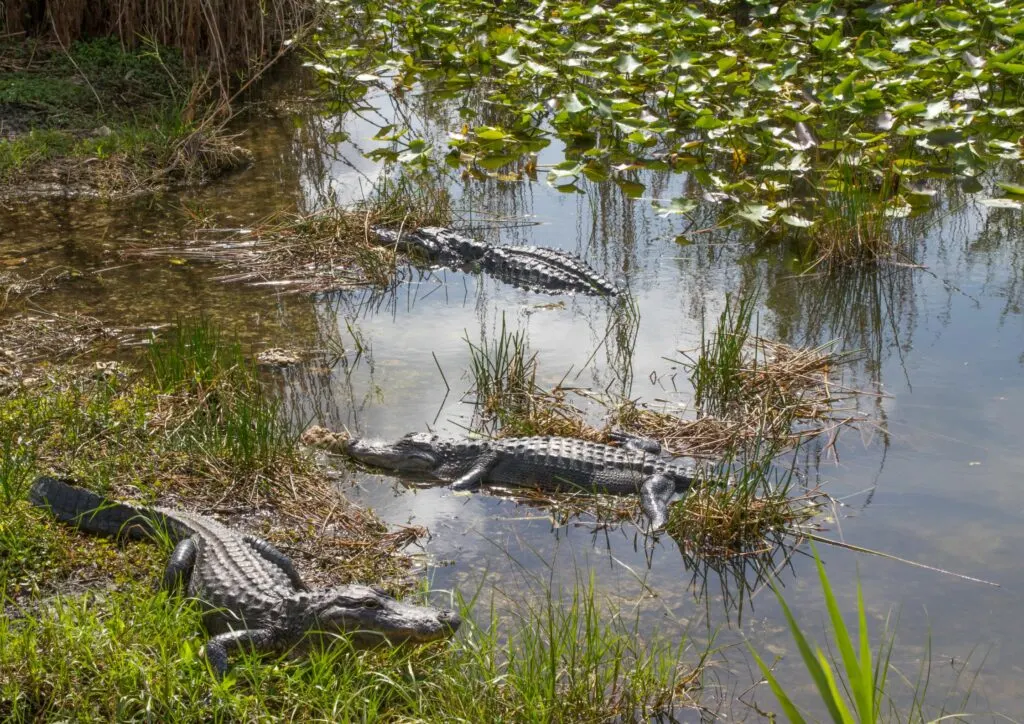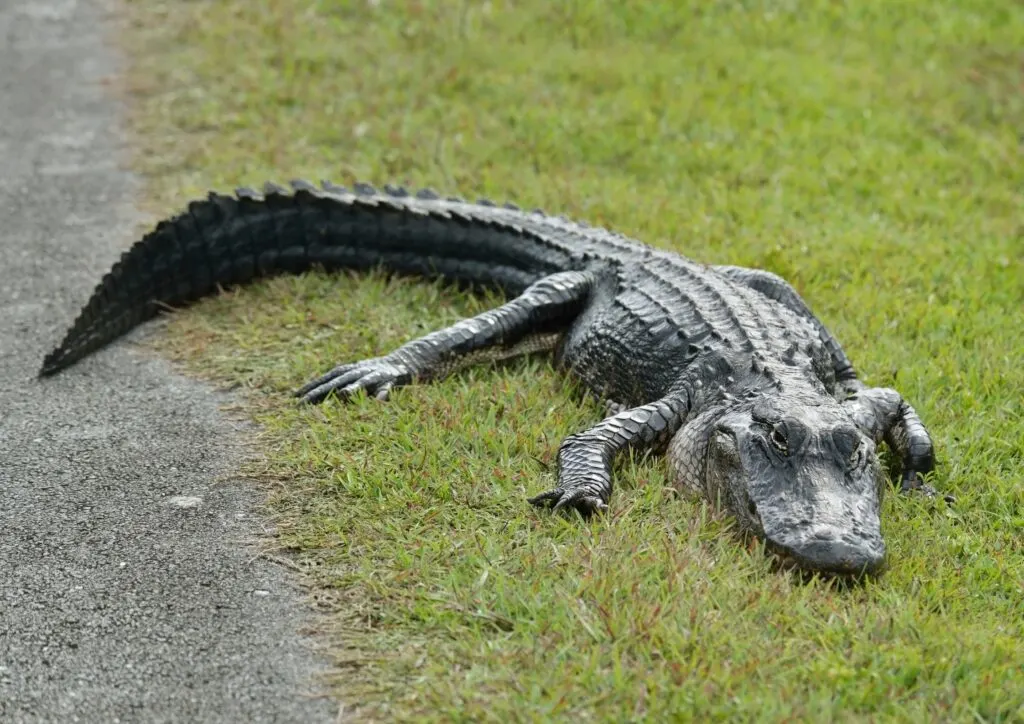Yes, there are crocodiles in Florida. If you are thinking – “hang on! I thought that there were only alligators in the United States?”, we are happy to say the sunshine state has more than just alligators.
South Florida is in fact the only place you will find both crocodiles and alligators co-existing. It sounds almost hard to believe (at least for us at first), but it is factual and fascinating. So what’s the deal? Are the crocodiles found in Florida man-hunting apex predators?
Are they native? How can you tell a crocodile apart from an alligator? And where can you spot them? We answer those next.
Crocodiles In Florida

If you ever watched Lake Placid, you’ll know these prehistoric-looking reptilian predators are not to be messed with. And like most water-based sci-fi movies, it creates an almost permanent fear of water bodies.
Crocodiles that call South Florida their home are better known as American crocodiles.
Just because we are not the biggest crocodile fans, we don’t discriminate, and we believe no matter how terrifyingly huge and threatening the American crocodile looks, it is unfortunate that these reptilian species are labelled a threatened species group.
Appearance – Thick Skin And Sharp Smiles!
While a crocodile’s thick skin is something – which is usually gray, they tend to have faded lines, which appear on their body from a super young age. The face is probably the most telling sign – crocodiles have a tapered snout.
The teeth look sharp and dashing. Hopefully, you never have to see one up close or in front of you. If it does, chances are you are about to be a watery snack.
An American crocodile can grow up to 17 feet and is roughly 453.5 Kilos heavy. Water is their turf, so it’s safe to assume they are experts when it comes to swimming. And given that they are apex predators, they are extremely quiet, lethal and super-fast – in water.
Habitat – Something in the water
According to the many studies done on these reptilian marvels, most American crocodiles tend to live closer to the northern end of South Florida. They require a warm tropical climate.
You will find them in saltwater regions like river estuaries, large ponds, creeks, mangrove swamps and even coves. Occasionally they do swim up and find themselves in freshwater regions as well.
Diet – Watch out boy they’ll chew you up!
The young crocs feed on small fish and other invertebrates. The larger ones or the adult diet include snakes, turtles, crabs, and even small mammals, which come near the waters to hydrate.
We are sure you are wondering “How about humans? Are they on the menu?”
While American crocodiles are known to be shy, there have been records of humans getting attacked. It’s not completely uncommon. As much as we don’t discriminate against these apex predators, they don’t discriminate against us and will consider us a good enough meaty meal – if we present them with the opportunity.
Where To Find Crocodiles In Florida?

The Everglades National Park
This 1.5 million-acre wetland preserve has been home to several endangered wildlife species like the Florida Panther and the leatherback turtle. The moving river/mangrove landscape and its subtropical conditions make the stunning Everglades ideal for crocodiles (and even alligators).
Turkey Point Nuclear Plant
The Turkey Point Nuclear Plant in Miami is said to be where nearly 25% of the crocodile population is. The plant’s canal system provides elevated areas like berms that are safe from flooding, where crocodiles find ideal to nest. Human interference is minimum here.
The Crocodile National Wildlife Refuge – located in the Keys
This stunning preserve homes salt marshes, mangrove forests and even hardwood hammocks. However, the bad news is, as much as it homes our star guest – the American crocodile, most travellers are not allowed to make visits.
The Rookery Bay in Naples
Another mangrove haven in the southwest of Florida, the Gulf of Mexico. It is 110,000 acres of vast mangrove forests/estuaries, and it borders the west side of the Everglades. Spotting the American crocodile here shouldn’t be a surprise.
Tampa Bay
There have been records of finding crocodiles that have been tagged in Turkey Point here.
Crocodiles vs Alligators

They do look quite similar, but they have major physical differences. When you understand what those differences are, you should be able to identify each without confusion.
Size
In size, they do look equal – at least at first glance. In fact, size might not be the first feature to use to check the differences. But if it’s the only option available, records show that crocodiles are heavier and longer compared to alligators.
Location
Crocodiles in the US are only found in the southernmost tip of Florida while alligators can be found in other southern states like Louisiana and big old Texas. It’s safe to say that based on observations, alligators are capable of withstanding slightly colder temperatures than crocodiles.
Colour
This is probably the most straightforward feature to use because it can be a dead giveaway – most times. Crocodile skin is generally gray and usually not all that dark in colour with a yellowish belly – which helps with camouflage.
Some saltwater crocodiles, however, have a more green-gray-ish coloured skin.
Alligators on the other hand are found in dark green, dark grey or black-brownish colours.
Teeth and Snout!
Our favourite part about any apex predator – teeth!
Crocodiles have a pointy triangular/ V-shaped snout. You can easily spot about four jagged bottom teeth when the jaw is tight shut.
Alligators on the other hand have blunt snouts. It’s more of a U-shape. And you can see jagged long teeth on the upper jaw when it’s tight shut.
Speed
Studies show that on land, crocodiles can make short distances at a speed of 32km per hour, whereas alligators can match up to a speed of 48km per hour.
In the water, alligators can still beat crocodiles in speed.
Frequently Asked Questions
What is the lifespan of American Crocodiles?
They can live up to 100 years in the right circumstances and conditions. But their average life span is around 60-70.
Do crocodiles naturally hunt humans?
They are generally timid creatures. They stay out of your way, but that doesn’t mean they won’t put up a fight if they feel threatened.
So respect their boundaries and don’t cause unnecessary disturbances – and you won’t be made an example out of.
Can you outrun a crocodile?
If you are a fit runner then yes. Don’t let their lazy sunbathing postures fool you, they can run like axe-murder chasing you down a street (Hollywood reality style) – and if they catch up – that’s bad news for you.
How to avoid a crocodile attack?
If you spot a croc, back away very gently and slowly, without creating too much noise or movement. And if you are in mangrove/wetland territory, just be mindful.
Is the American Crocodile native to Florida?
Yes.

